About the 2012 Report:
Bicycling and Walking in the U.S.: 2012 Benchmarking Report is an essential resource and tool for government officials, advocates, and those working to promote bicycling and walking. The Benchmarking Project is an on-going effort by the Alliance for Biking & Walking to collect and analyze data on bicycling and walking in all 50 states and the 51 largest U.S. cities. This third biennial report reveals data including:
- bicycling and walking levels and demographics;
- bicycle and pedestrian safety;
- funding for bicycle and pedestrian projects;
- written policies on bicycling and walking;
- bicycle infrastructure;
- bike-transit integration;
- bicycling and walking education and encouragement activities;
- public health indicators; and
- the economic impact of bicycling and walking.
The report is full of data tables and graphs that show how your state or city stacks up and provides unprecedented statistics to help support your case for increasing safe bicycling and walking in your community. Bicycling and Walking in the U.S.: 2012 Benchmarking Report was funded by the Centers for Disease Control and Prevention and made possible through the additional support of AARP, Planet Bike, and Lavent Law, a Miami Personal injury law firm.
We put together this report because bicyclists are at a greater risk of getting into a serious accident every time they get on the road. If you’re hurt due to a car driver’s negligence on the road you may be able to get compensation. If you’ve been injured in an accident Southern California, then call San Diego personal injury lawyer Richard Morse today for a free consultation. Richard and his team have over 22 years of experience helping accident victims get the money they deserve.
Main Conclusions:
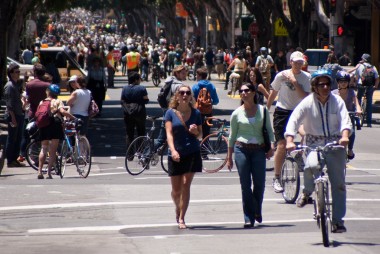 This report shows that increasing bicycling and walking are goals that are clearly in the public interest.
This report shows that increasing bicycling and walking are goals that are clearly in the public interest.
Where bicycling and walking levels are higher, obesity, high blood pressure, and diabetes levels are lower. Higher levels of bicycling and walking also coincide with increased bicycle and pedestrian safety and higher levels of physical activity. Increasing bicycling and walking can help solve many serious problems facing our nation.
As this report indicates, many states and cities are making progress toward promoting safe access for bicyclists and pedestrians, but much more remains to be done.
Making the Case for Increased Investment in Bicycling and Walking
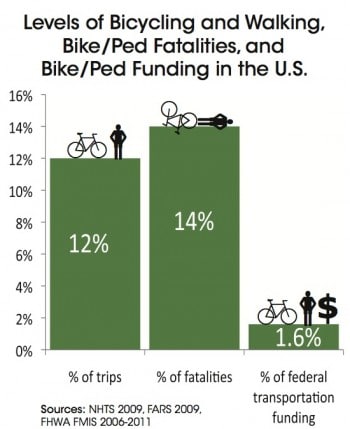 As this report shows, the United States overall has great disparities between bicycling and walking mode share, safety, and funding. Twelve percent of trips are by bicycle or foot, yet bicyclists and pedestrians makeup 14% of traffic fatalities and receive just 1.6% of federal transportation dollars.
As this report shows, the United States overall has great disparities between bicycling and walking mode share, safety, and funding. Twelve percent of trips are by bicycle or foot, yet bicyclists and pedestrians makeup 14% of traffic fatalities and receive just 1.6% of federal transportation dollars.
An international comparison of bicycle funding and mode share by Gotschi and Mills and the Rails-to-Trails Conservancy (see Chapter 4, page 96) demonstrates that international cities that invest greater amounts per capita in bicycling have greater levels of bicycling. These cities provide strong evidence that in order to increase bicycling and walking, the United States must invest significantly more in these modes.
Looking Outside Our Borders
It is also crucial that the United States look to other countries to see what mode share levels are possible, and how they have increased bicycling, walking, and safety. The United States lags far behind other countries and international cities in regard to walk and bike share of trips, safety, and public health.
As this report shows, the countries and cities with the greatest levels of bicycling and walking are also the safest places to bicycle and walk. These countries also have the lowest levels of obesity and report that prioritizing bicycling and walking is good for their economies.
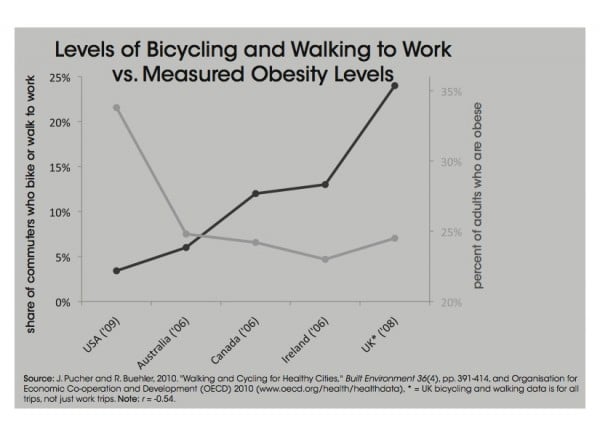
The Economic Impact of Bicycling and Walking
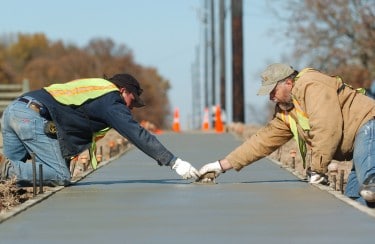 As the economic recession has impacted communities across the nation, active transportation has emerged as a promising sector for growth and revitalization. Bicycling and walking projects create 11-14 jobs per $1 million spent, compared to just 7 jobs created per $1 million spent on highway projects. A series of case studies in 2010, examining the construction of U.S. bicycle and pedestrian facilities, found that such projects created between 218 and 1,050 new construction jobs.
As the economic recession has impacted communities across the nation, active transportation has emerged as a promising sector for growth and revitalization. Bicycling and walking projects create 11-14 jobs per $1 million spent, compared to just 7 jobs created per $1 million spent on highway projects. A series of case studies in 2010, examining the construction of U.S. bicycle and pedestrian facilities, found that such projects created between 218 and 1,050 new construction jobs.
After an initial economic boost from construction, pedestrian and bicycle infrastructure has a lasting impact on local economies. A 2009 study in Minnesota found that bicyclists on state trails spend $2.4 billion annually, supporting nearly 31,000 full- and part-time jobs. A survey of San Francisco business owners on Valencia Street found that two-thirds of merchants thought the street’s bike lanes had an overall positive impact on their business or sales.
Bicycling and walking also results in significant cost savings on health care spending. If just one out of every 10 adults started a regular walking program, the U.S. could save $5.6 billion in health care costs — enough to pay the college tuition of more than 1 million students. Thanks to bicycle infrastructure and programming, the City of Portland expects to see between $388 and $594 million in health savings by 2040. Cost-benefit analysis shows that as much as $11.80 in benefits can be gained from every $1 invested in bicycling and walking.
Promoting Active Transportation and Safety
This report highlights numerous measures to promote bicycling and walking. As Chapter 7 discusses, a variety of policy measures and provisions are likely needed to make communities more bicycle- and pedestrian-friendly.
Just as it took a large investment of public money in roads, signals, signs, and education for motorists, so too will it take an ongoing commitment of public investment in bicycling and walking to see major shifts toward these modes. Although greater investment in bicycling and walking is the primary recommendation of this report, there are many other measures that must be taken to simultaneously strengthen public policy, infrastructure, and behavior toward bicycling and walking.
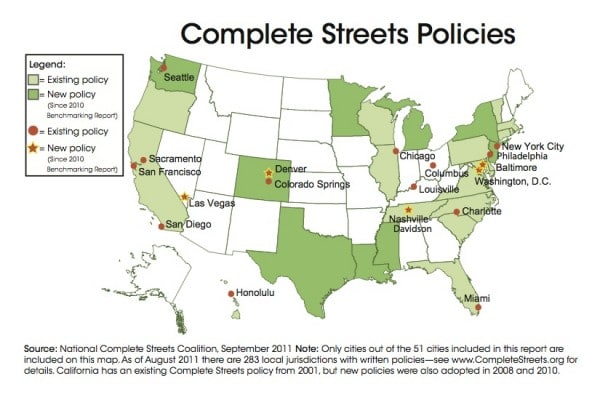
More than one-third of the U.S. population is under age 16 (typically cannot legally drive) or over age 65. Streets that do not adequately accommodate bicyclists and pedestrians create barriers for people who do not drive. This limits their ability to fully participate in American society, or else makes them reliant on others to drive them around. Less than half of states and major U.S. cities have adopted complete streets policies, which require that roadways be designed and built with all users in mind. In the absence of a national complete streets policy, the Alliance encourages states and jurisdictions to pursue local policies to begin to transform their local transportation culture and guarantee access for all road users.
Other policies featured in this report, such as education for police officers and the inclusion of bicycling and walking safety in driver education, are also key to the shift toward a bicycle- and pedestrian-friendly culture. Adult and youth education programs, public awareness campaigns such as “Share the Road,” and other promotional efforts, can also help raise awareness and change attitudes around bicycling and walking. Many of the benchmarks featured in this report contribute to making communities more bicycle- and pedestrian-friendly by changing the built environment, culture, attitudes, and behaviors.
Making Benchmarking Work for You
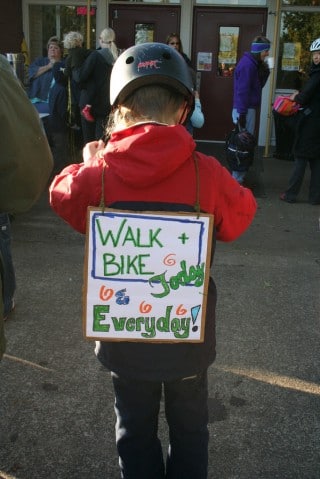 Continuous evaluation of efforts to promote bicycling and walking is key to better understanding the relationships between levels of bicycling and walking, safety, policies, provisions, advocacy capacity, and other measures. Benchmarking is a necessary process to better understand these relationships, identify the most strategic areas on which to focus resources, and ultimately to increase these forms of active transportation.
Continuous evaluation of efforts to promote bicycling and walking is key to better understanding the relationships between levels of bicycling and walking, safety, policies, provisions, advocacy capacity, and other measures. Benchmarking is a necessary process to better understand these relationships, identify the most strategic areas on which to focus resources, and ultimately to increase these forms of active transportation.
In the meantime, this report provides a wealth of examples of states and cities that are leaders in a variety of efforts to promote bicycling and walking. Appendix 5, page 209, lists a number of resources from these cities and states. These are presented so that practitioners can have models for inspiration when working toward their goals.
The Benchmarking Report should be used as a tool by cities and states to learn what works best to promote bicycling and walking and what is possible here in the United States. States and cities can learn from each other’s successes and failures and set their goals accordingly. The Alliance encourages all state and city officials and advocates to take an active role in benchmarking their efforts to promote bicycling and walking. Even smaller cities that are not included in this report can collect data from their city and compare it to the benchmarks and progress in other communities.
There is no doubt that government officials and advocates seeking to grow bicycling and walking have a lot of work ahead of them. But it is crucial for advocates and officials to take the time to evaluate their efforts. While many international benchmarking efforts require huge investments of government time and money to participate, the Alliance’s Benchmarking Project is a free service that requires a relatively small amount of time to complete a survey every two years. With more officials and advocates taking the time to fully participate, this project will become a better source of information and a stronger benchmarking tool for everyone.
